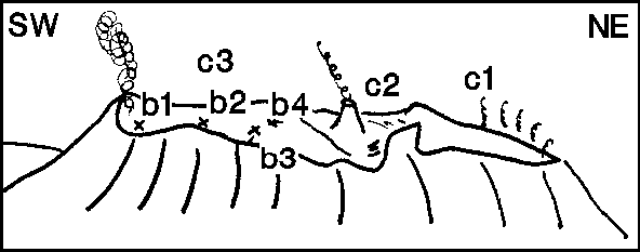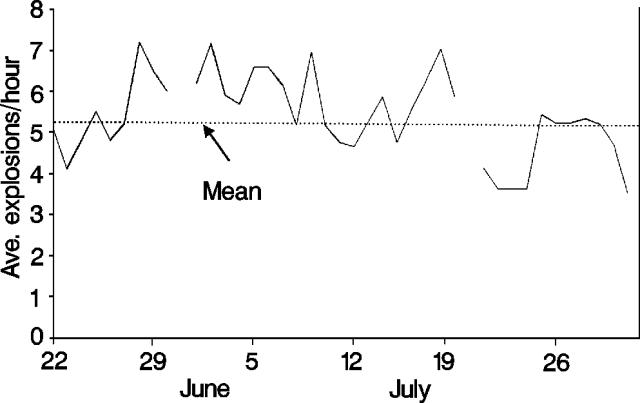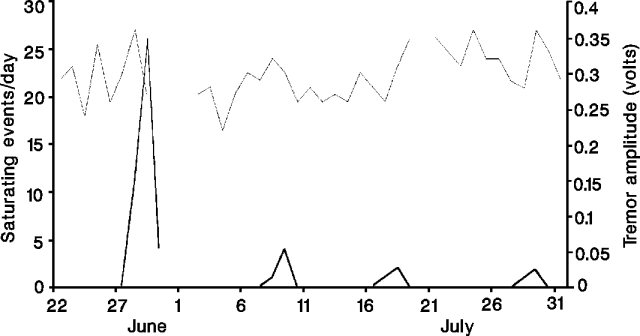Report on Stromboli (Italy) — August 1991
Bulletin of the Global Volcanism Network, vol. 16, no. 8 (August 1991)
Managing Editor: Lindsay McClelland.
Stromboli (Italy) Continued moderate explosive activity; gas data
Please cite this report as:
Global Volcanism Program, 1991. Report on Stromboli (Italy) (McClelland, L., ed.). Bulletin of the Global Volcanism Network, 16:8. Smithsonian Institution. https://doi.org/10.5479/si.GVP.BGVN199108-211040
Stromboli
Italy
38.789°N, 15.213°E; summit elev. 924 m
All times are local (unless otherwise noted)
Explosive activity was restricted to crater C1 (NE part of the summit area; figure 17) during 9 August fieldwork (by F. Iacop, Institute of Earth Sciences, Univ of Udine). C1's central cone ejected hot tephra at ~20-minute intervals, and as a result, it had grown more rapidly than the crater's other two active cones. Glow from two small radial fissures in crater C2 was clearly visible at night. Sustained noisy gas emissions occurred about once an hour. Volcano guides had reported that activity was concentrated in crater C3 (SW part of the summit area), but at its cone 1 only hot vapor emission was occurring, from two vents, on 9 August. Rare explosions, mostly ejecting tephra, took place at bocca 4. The average number of recorded earthquakes remained near the normal value of 6/hour in July, declining below that level in the month's last week (figure 18). Average tremor amplitude also remained relatively constant through the end of July, while large shocks nearly disappeared after a peak on 29 June (figure 19). [see 16:09 for 28-29 August observations].
 |
Figure 17. Active craters at Stromboli as seen from the somma, 6 September 1991. Crosses mark small vents active during the 6 September fieldwork. Courtesy of the Société Volcanologique Européenne. |
 |
Figure 18. Average number of explosion events/hour at Stromboli, 22 June-31 July 1991. The mean value for the period is shown. Courtesy of M. Riuscetti. |
 |
Figure 19. Number of seismometer-saturating events/day (lower curve) and average daily tremor amplitude (upper curve) at Stromboli, 22 June-31 July 1991. Courtesy of M. Riuscetti. |
Moderate activity was observed in early September, with explosive episodes about every 15 minutes at crater C3 and roughly hourly at C1. Activity increased in the 3 hours of observations after 2300 on 6 September, with many moderate to strong explosions from the SW part of C3. Ejections of incandescent bombs and scoria sometimes lasted several minutes. Thick white vapor plumes rose from C2 and a small cone in its center, while blue SO2-rich plumes emerged from several other vents. Explosions from C1 were vigorous, ejecting glowing fragments and dark brown columns that rose 200 m above the crater. C3's smaller explosive bursts, consisting of tephra-poor incandescent gas jets, were usually preceded by comparatively brief periods of increasing, noisy gas puffs; larger explosions that ejected a higher proportion of tephra followed longer intervals, with fewer or no precursory gas puffs. Geologists attributed this pattern to intermittent closure (by cooling) of the lava-filled conduits to gas-bubble rise from the underlying magma body, allowing higher pressure to build at depth.
Airborne COSPEC measurements by an Italian-French cooperative program in May-July indicated a total SO2 flux somewhat lower than that measured by the same means in 1980 and 1984 (1,000 ± 200 t/d average; Allard and others, in press), consistent with the current moderate activity. Geologists concluded that combined with microprobe determination of the initial and residual sulfur content of Stromboli's lava, the SO2 flux data require the degassing of 0.1 km3/year (average) of magma, three orders of magnitude more than the co-erupted volume. Thus, gas output is essentially derived from magma stored within the volcano. To assess the amount of diffuse magmatic degassing through the volcanic pile, other than from the craters, infrared mass spectrometric profiling of CO2 concentrations in the ground began on 11 September. High CO2 levels (80-90%), associated with subsurface thermal anomalies, were found to characterize the Pizzo sopra La Fossa crater terrace (at the summit rim, SE of the active craters). Concentrations gradually decreased toward the rim of this former crater, and no CO2 anomaly was detected in outer areas to the S (down to the Vancori rampart).
Reference. Allard, P., Carbonelle, J., Le Bronec, J., Metrich, N., and Zetwoog, P., Volatile flux and magma degassing budget at Stromboli volcano: Geophysical Research Letters, in review.
Geological Summary. Spectacular incandescent nighttime explosions at Stromboli have long attracted visitors to the "Lighthouse of the Mediterranean" in the NE Aeolian Islands. This volcano has lent its name to the frequent mild explosive activity that has characterized its eruptions throughout much of historical time. The small island is the emergent summit of a volcano that grew in two main eruptive cycles, the last of which formed the western portion of the island. The Neostromboli eruptive period took place between about 13,000 and 5,000 years ago. The active summit vents are located at the head of the Sciara del Fuoco, a prominent scarp that formed about 5,000 years ago due to a series of slope failures which extends to below sea level. The modern volcano has been constructed within this scarp, which funnels pyroclastic ejecta and lava flows to the NW. Essentially continuous mild Strombolian explosions, sometimes accompanied by lava flows, have been recorded for more than a millennium.
Information Contacts: M. Riuscetti, Univ di Udine; Patrick Allard, CNRS-CEA, France; J.C. Baubron, BRGM, France; H. Gaudru and Rolf Haubrichs, SVE, Switzerland; Yvonne Miller, Univ de Genève, Switzerland.

